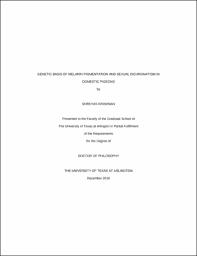
ATTENTION: The works hosted here are being migrated to a new repository that will consolidate resources, improve discoverability, and better show UTA's research impact on the global community. We will update authors as the migration progresses. Please see MavMatrix for more information.
Show simple item record
| dc.contributor.advisor | Fondon III, John W. | |
| dc.creator | Krishnan, Shreyas | |
| dc.date.accessioned | 2019-07-17T20:36:07Z | |
| dc.date.available | 2019-07-17T20:36:07Z | |
| dc.date.created | 2016-12 | |
| dc.date.issued | 2016-12-09 | |
| dc.date.submitted | December 2016 | |
| dc.identifier.uri | http://hdl.handle.net/10106/28385 | |
| dc.description.abstract | Deciphering the genetic basis of pigmentation in domestic pigeons (Columba livia) affords a unique opportunity to connect microevolution to macroevolution. Domestic pigeons have far greater phenotypic diversity than other domesticates that often recapitulate traits that occur in nature. By using classical genetic approaches and by leveraging the innumerable meiotic events since the advent of pigeon domestication, and population structure, I have mapped traits to genes and begun to deconstruct more complex traits. In this process of investigation one expects to discover mechanisms that may be generalizable to some extent to other birds; however, their generality may be limited in their extent as they are products of intense artificial selection.
In this volume I have mapped well characterized monogenic or Mendelian pigeon pigmentation traits to their genetic underpinnings. As pioneers in this system, since the last workers (up until the 1940s), my approach is akin to using pigeon breeds as Petri dishes and intercrosses as inoculation experiments. In this process, by moving traits into different genetic contexts I am deconstructing genetic pathways and validating and extending our knowledge of melanin synthesis. Some of my results initially appear contradictory to expectation, as in the case of the phenotype associated with the gene Mc1r and the characteristics of the smoky trait. In other cases including some not presented in this volume we have concordance with the predictions from pigmentation studies in other systems.
Birds undoubtedly have among the most flamboyant displays and colors used in courtship and combat rituals, and possess some dramatic sexual dimorphisms, yet the sexes of wild rock pigeons (Columba livia) are uniform in appearance, a slate blue-gray with black markings. Sexual dichromatism can evolve in several ways involving antagonistic and/or sexual selection. While sex-linkage is not necessary for the evolution of sexual dimorphisms, theory predicts that sex linkage should favor the evolution of such traits. Early pigeon fanciers characterized sexually dichromatic sex-linked pigmentation traits and created breeds in which sexes can be readily distinguished as early as hatchlings. Mapping this locus helps us understand the possible roles of as yet poorly known players in the melanogenesis pathway and mechanisms by which they may contribute toward pigmentation diversity,
The repeated evolution of traits due to the same genetic players and pathways is support for the conserved nature of the genetic toolkit. The genetic associations in this volume can be leveraged in future studies to dissect more complex pigmentation traits and our knowledge from domestic pigeon pigmentation genetics may be extended to birds in general. | |
| dc.format.mimetype | application/pdf | |
| dc.language.iso | en_US | |
| dc.subject | Pigeons | |
| dc.subject | Domestic | |
| dc.subject | Columba livia | |
| dc.subject | Pigmentation | |
| dc.subject | Genetics | |
| dc.subject | Mc1r | |
| dc.subject | Mlana | |
| dc.title | GENETIC BASIS OF MELANIN PIGMENTATION AND SEXUAL DICHROMATISM IN DOMESTIC PIGEONS | |
| dc.type | Thesis | |
| dc.degree.department | Biology | |
| dc.degree.name | Doctor of Philosophy in Quantative Biology | |
| dc.date.updated | 2019-07-17T20:36:07Z | |
| thesis.degree.department | Biology | |
| thesis.degree.grantor | The University of Texas at Arlington | |
| thesis.degree.level | Doctoral | |
| thesis.degree.name | Doctor of Philosophy in Quantative Biology | |
| dc.type.material | text | |
Files in this item
- Name:
- KRISHNAN-DISSERTATION-2016.pdf
- Size:
- 1.860Mb
- Format:
- PDF
This item appears in the following Collection(s)
Show simple item record


